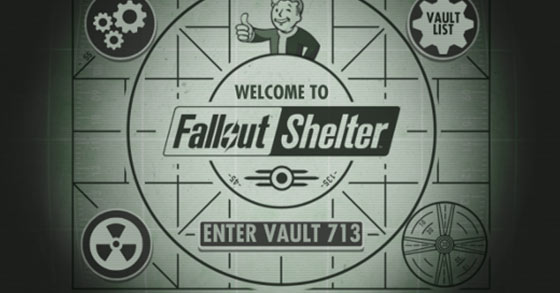Fallout Shelter Android review, Bethesda´s highly addicting management simulator


- Gameplay

- Graphics

- Sound/Music

- Controls

- Replay Value

Survival has been a key aspect to the Fallout series. Managing inventory, collecting salvage, and maintaining equipment is necessary for traversing the Wasteland, whether it’s because the Overseer needs a water chip or just wants someone dead without getting blood on their hands. There’s also the probability that the Vaults could either be safe havens for future generations of mankind or social experiments that usually end in ghastly results. Fortunately, Fallout Shelter’s experiment is how long the addiction will last.
Gameplay is fairly simple and straightforward. The player builds their Vault room by room and recruits characters to become Vault Dwellers. The starting rooms are essential to keeping the Vault going by supplying power, water, and food while more unlockable rooms provide more benefits as the population grows. Rooms require a certain attribute on a Dweller’s SPECIAL (Fallout’s primary statistic) to operate the room, with using multiple Dwellers with high attributes in a single room to increase production.
A Dweller’s SPECIAL can be increased by either outfits that increases certain attributes or intense training. Late game rooms include intense training facilities that increases a single SPECIAL attribute and higher tier, and costly, production rooms. All the rooms can be merged for more Dwellers to be assigned to and upgraded for increased production and storage space. Rushing production can produce the product faster while giving out bonuses but there is a chance for it to fail that increases after each time it is done.
Spending Dwellers out into the Wasteland is the main method to acquire caps (the currency of the Fallout world), outfits, and weapons. The outcome of the Dweller and equipment found is based on how long they traveled and how well they are prepared in terms of levels, SPECIAL stats, equipment, and their personal stock of Stimpacks and Radaway (for health and radiation poisoning respectively).
While the Dwellers in the Wasteland will face some obstacles, there will be some dangers in the Vault. The occasional fire incident can occur, but the more serious damage dealing problems come from Radroaches and Molerats that stops a room’s production, raiders breaking in to steal resources, and Deathclaws charging in to slaughter anything that moves. Completing a week with high grades of the Dwellers’ overall happiness or meeting a random objective can produce a free Lunchbox for a chance to gain caps, resources, equipment, or a special Dweller. Lunchboxes can also be purchased along with Mr. Handy bots, which can act as a Dweller (does not count as part of the population) and collect resources for you, from the shop ranging from $0.99 to $19.99.
The graphics use a combination of 3D modeled environments and sprite characters. The rooms are well detailed with the 50s style the series is known for with animations to add to the aesthetics, but it appears that no expense was spared when compared to the sterile walls of Vaults 13 and 101. The Vault Dweller designs are based on Vault-Tec’s mascot, Vault Boy, with varying features such as facial and hair styles, and their appearance change depending on the outfit they’re equipped with. Their animation resembles Scribblenauts but simplicity works for this game. The music, while not as memorable as The Ink Spots songs previously used in the series, keeps with the consistency of using the 50s theme.
Controls use a simple point and drag that is common with a number of smart phone games. The touch screen controls everything in the game, and it’s easy to operate, but a tiny screen could have some minor issues with scrolling. It’s also just as easy to accidentally drop a Dweller in the wrong room or touch outside of an option box since the buttons can be small on a little handheld device.
Pros:
+ A free game with no paywalls. It can be played without any micro transactions.
+ Difficulty scales as the Dweller population grows, giving more time to develop the Vault and acquire equipment.
Cons:
– Best played in small sessions. Waiting for progress can take hours even when upgrades were made.
Gameplay: 4/5
Graphics: 4/5
Sound/Music: 3/5
Controls: 3/5
Replay Value: 1/5

Verdict: 3.5/5
Fallout Shelter is a fun and addicting game but patience is a requirement to play since it could take hours for productivity. Despite this, however, it’s good enough to kill some time whether it’s at work or waiting in line to get a copy of Fallout 4. And with no paywalls or any need for micro transactions Fallout fans can save some caps for the upcoming game. Now isn’t that a kick in the head?
Title: Fallout Shelter
Developer: Bethesda Game Studios, Behaviour Interactive
Format: Android
Genre: Construction and management simulation
Resolution: Depends on device
Release date: 2015-06-14
Difficulty: Normal
Spent time: 4 hours
Average grade internationally: 72.04%
PEGI age rating/ESRB: PEGI 16/Mature 17+
Price: Free/Micro transaction Shop
![]()
David Lucas
The Gaming Ground
Twitter: @GamerFoxem
More by Guest Author:
- Farming Simulator 25 mods – downloading, installing & more
- Here are the top five most popular games of 2024 you need to play
- The role of music and soundtracks in creating immersive gaming worlds
- FS25 is coming this Fall (2024) with a large selection of mods
- How technology and social media have influenced the gambling industry
Tags: Android, Android review, Behaviour Interactive, Bethesda Game Studios, Fallout, Fallout Shelter
























